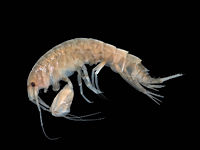Portal:Crustaceans
The Crustaceans Portal Crustaceans are a group of arthropods that are a part of the subphylum Crustacea (/krəˈsteɪʃə/), a large, diverse group of mainly aquatic arthropods including decapods (shrimps, prawns, crabs, lobsters and crayfish), seed shrimp, branchiopods, fish lice, krill, remipedes, isopods, barnacles, copepods, opossum shrimps, amphipods and mantis shrimp. The crustacean group can be treated as a subphylum under the clade Mandibulata. It is now well accepted that the hexapods (insects and entognathans) emerged deep in the Crustacean group, with the completed group referred to as Pancrustacea. The three classes Cephalocarida, Branchiopoda and Remipedia are more closely related to the hexapods than they are to any of the other crustaceans (oligostracans and multicrustaceans). The 67,000 described species range in size from Stygotantulus stocki at 0.1 mm (0.004 in), to the Japanese spider crab with a leg span of up to 3.8 m (12.5 ft) and a mass of 20 kg (44 lb). Like other arthropods, crustaceans have an exoskeleton, which they moult to grow. They are distinguished from other groups of arthropods, such as insects, myriapods and chelicerates, by the possession of biramous (two-parted) limbs, and by their larval forms, such as the nauplius stage of branchiopods and copepods. Most crustaceans are free-living aquatic animals, but some are terrestrial (e.g. woodlice, sandhoppers), some are parasitic (e.g. Rhizocephala, fish lice, tongue worms) and some are sessile (e.g. barnacles). The group has an extensive fossil record, reaching back to the Cambrian. More than 7.9 million tons of crustaceans per year are harvested by fishery or farming for human consumption, consisting mostly of shrimp and prawns. Krill and copepods are not as widely fished, but may be the animals with the greatest biomass on the planet, and form a vital part of the food chain. The scientific study of crustaceans is known as carcinology (alternatively, malacostracology, crustaceology or crustalogy), and a scientist who works in carcinology is a carcinologist. (Full article...) Selected article
Metanephrops challengeri (commonly known as the New Zealand lobster or New Zealand scampi) is a species of slim, pink lobster that lives around the coast of New Zealand. It is typically 13–18 cm (5–7 in) long and weighs around 100 g (3.5 oz). The carapace and abdomen are smooth, and adults are white with pink and brown markings and a conspicuous pair of long, slim claws. M. challengeri lives in burrows at depths of 140–640 m (460–2,100 ft) in a variety of sediments. Although individuals can live for up to 15 years, the species shows low fecundity, where small numbers of larvae hatch at an advanced stage.
M. challengeri is a significant prey item for ling, as well as being an important fishery species for human consumption; trawlers catch around 1,000 t (2,200,000 lb) per year under the limitations of New Zealand's Quota Management System. The species was first collected by the Challenger expedition of 1872–1876, but only described as separate from related species by Heinrich Balss in 1914. Although originally classified in the genus Nephrops, it was moved in 1972 to a new genus, Metanephrops, along with most other species then classified in Nephrops. Did you know?
Selected biographyWilliam Elford Leach FRS (February 2, 1790 – August 26, 1836) was an English zoologist and marine biologist. In 1813, Leach was employed as assistant librarian in the Zoological Department at the British Museum. He set himself to sorting out the collections, many of which had been neglected since they had been left to the museum by Hans Sloane. During his time there he was made assistant keeper of the natural history department and became an expert on crustaceans and molluscs. In 1817, he was elected a fellow of the Royal Society. Leach also worked and published on insects, myriapods, arachnids, mammals and birds. Leach's nomenclature was a little eccentric - he named twenty-seven species after his friend John Cranch, who had collected the species in Africa and later died on HMS Congo. In 1818, he named nine genera after Caroline or anagrams of that name, possibly after his mistress. In 1821, he suffered a nervous breakdown due to overwork, and he resigned from the museum in March 1822. His elder sister took him to continental Europe to convalesce, and they travelled through France, Italy and Greece. He died of cholera in the Palazzo San Sebastiano, near Tortona, north of Genoa. Selected image Nototropis falcatus (formerly Atylus falcatus) is a species of amphipod from sandy bottoms in the North Atlantic and North Sea. General imagesThe following are images from various crustacean-related articles on Wikipedia.
Crustacean lists
SubcategoriesRelated portalsWikiProjectsAssociated WikimediaThe following Wikimedia Foundation sister projects provide more on this subject:
Discover Wikipedia using portals
|





















































